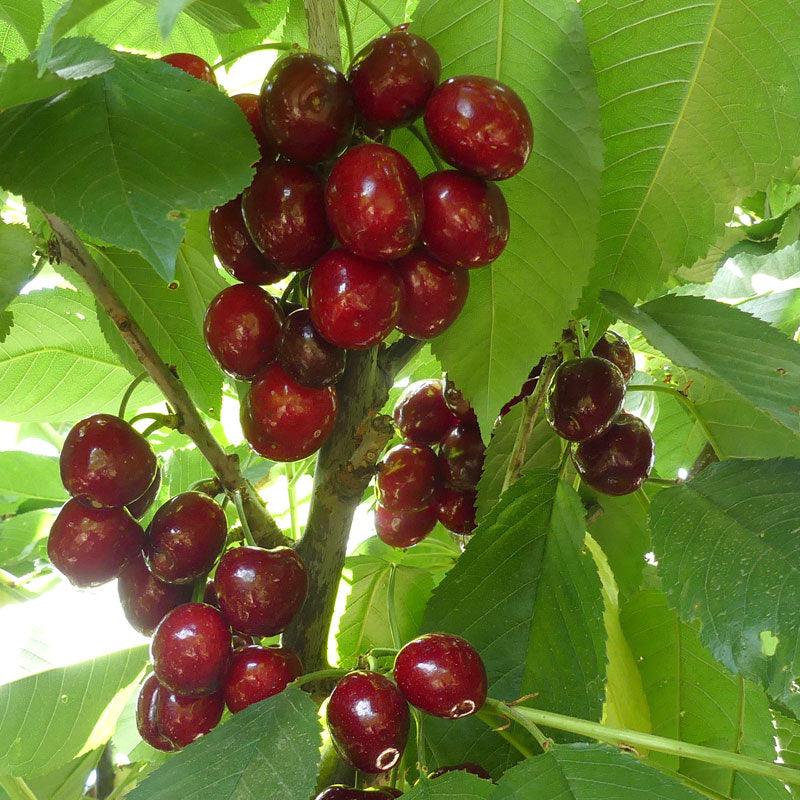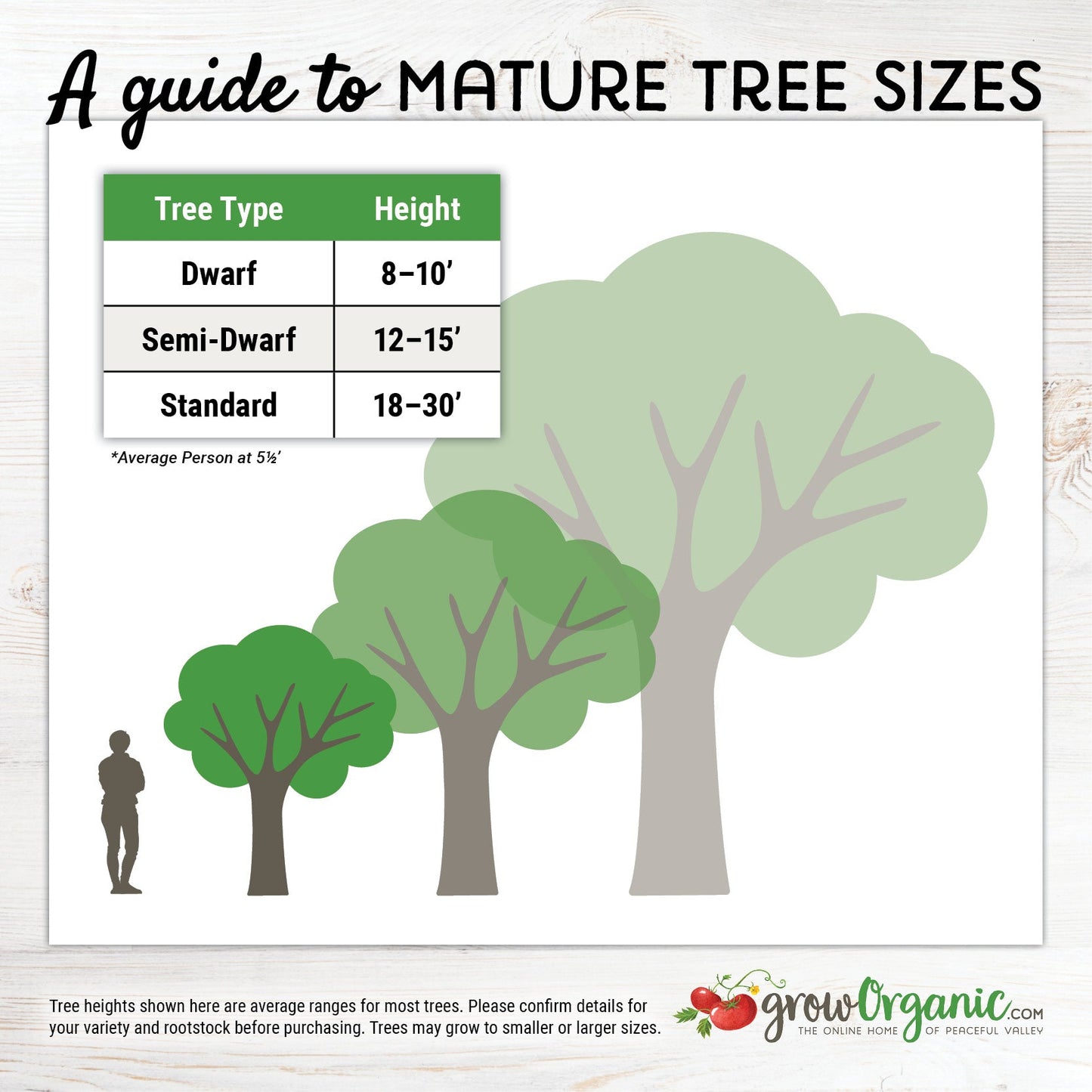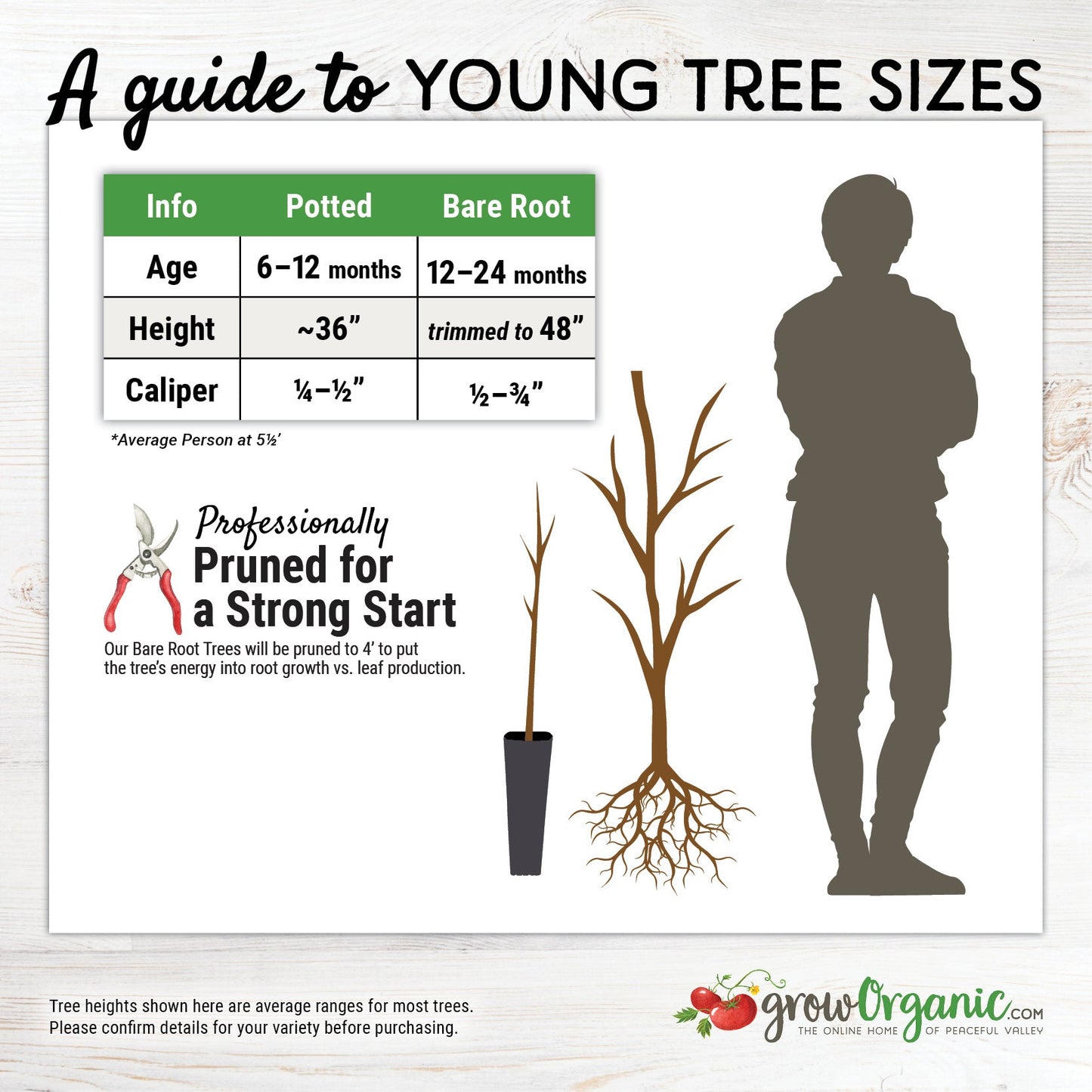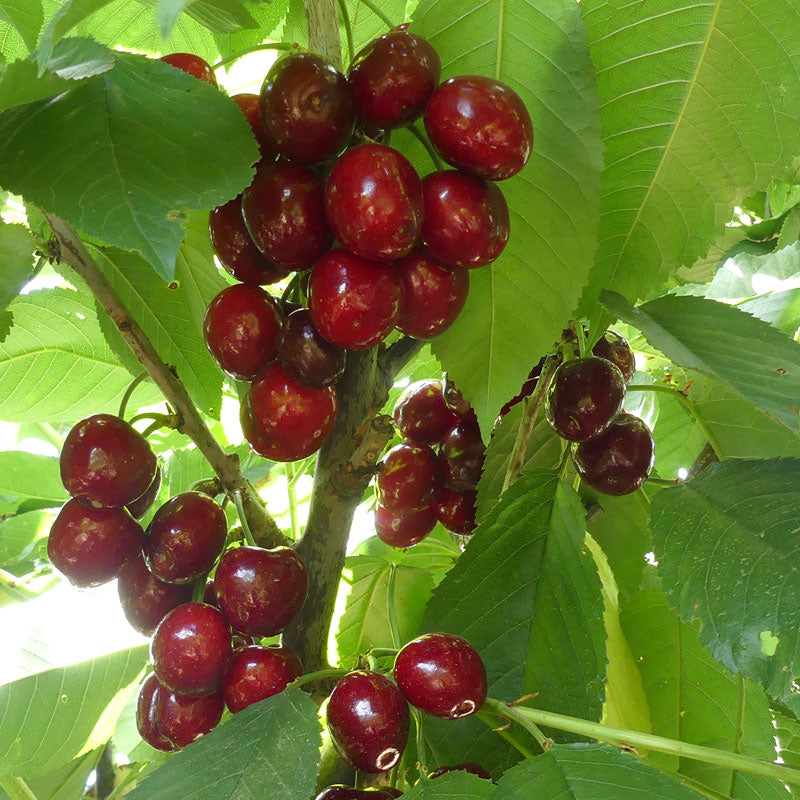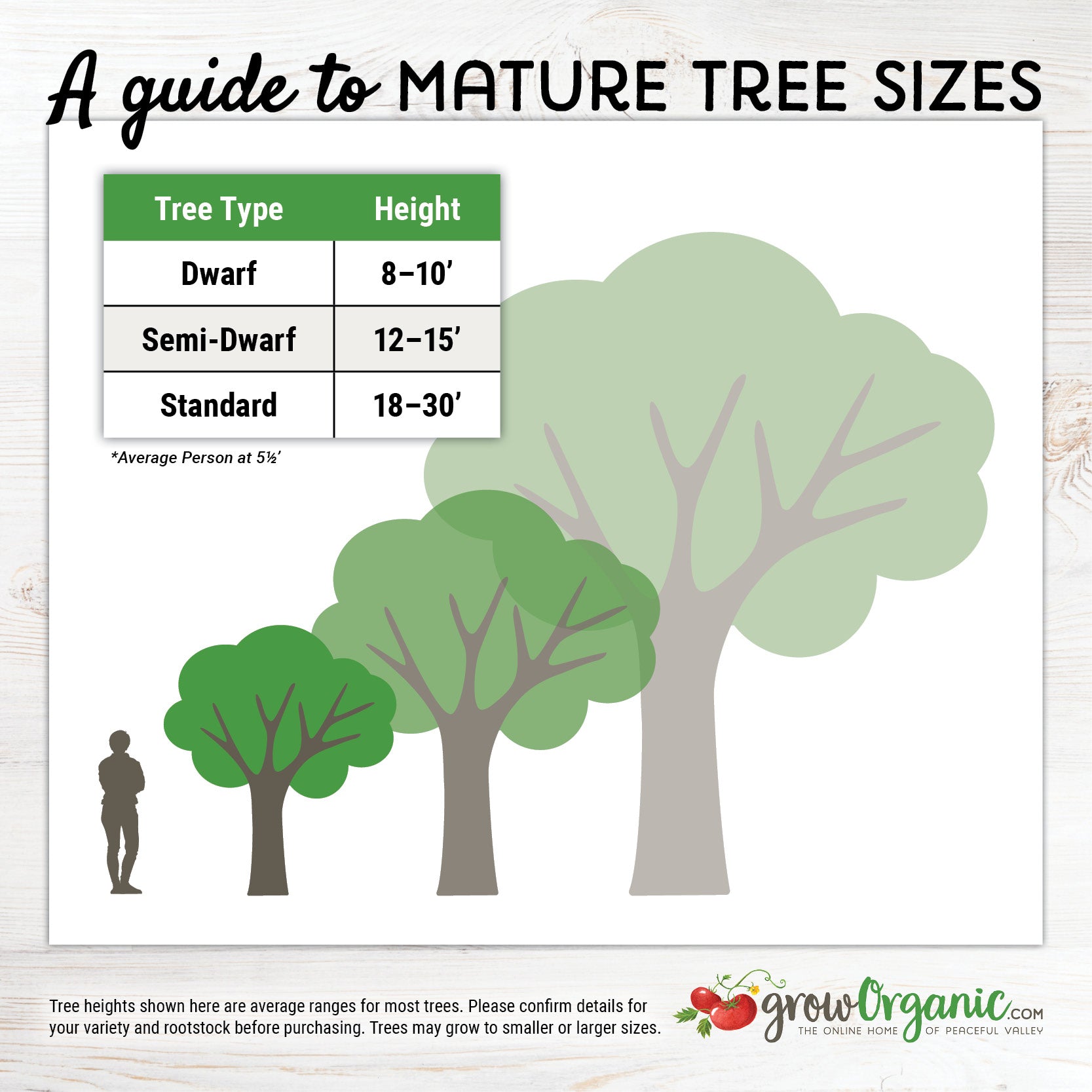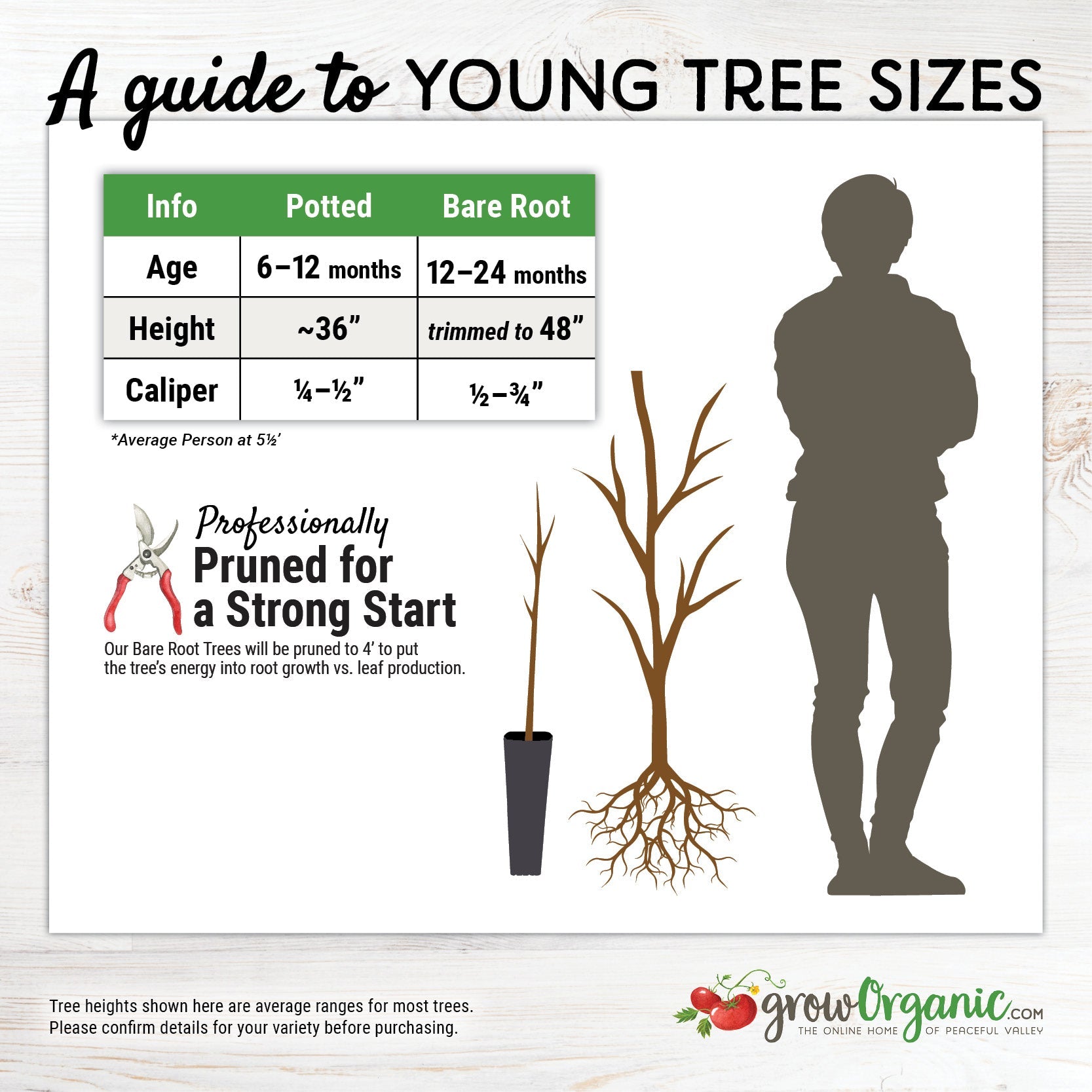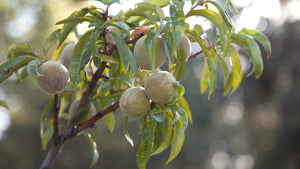Item Number: FT093
Lapins Cherry Tree
Lapins Cherry Tree
Huge Sweet Late Cherries
Semi-dwarf on Maxma rootstock.
- Zones: 5-9
- Chill hours: 400-500
- Bloom Time: Mid-Season (Based on typical Central Valley California weather)
- Harvest: May 29 - June 14
- Looks: Large, firm, dark red cherry.
- Personality: Good sweet flavor.
- Facts of note: Large, high quality dark red fruit is sweet with a firm texture and juicy flesh. A self fruitful Bing type cherry with excellent quality fruit that is resistant to cracking. A great backyard cherry for those who love the idea of having a Bing Cherry, but don't have the room for the second pollinating variety. While Lapins is self fruitful, it also acts as a pollinator for other popular sweet cherries. Ripens at the same time as the Bing. These big, firm fruit are at their best eaten fresh, but you could also use them in pies, jams, sauces, or dry them for a real winter treat. Also sold as "Self-fruitful Bing'"
- Pollination: Self-fruitful.
Cherries are a beloved fruit known for their sweet and tart flavors, making them a popular addition to gardens and orchards. Among the many cherry varieties available, the Lapins Cherry Tree stands out as an excellent choice for both amateur and experienced fruit growers.
Overview of the Lapins Cherry Tree
The Lapins Cherry Tree is a member of the Prunus genus, known for producing high-quality cherries. This particular cultivar is prized for its sweet, dark red cherries that are perfect for eating fresh, baking, or preserving into jams and jellies. Here are some key features of the Lapins Cherry Tree:
Semi-Dwarf Growth Habit: The semi-dwarf nature of this tree makes it an ideal choice for small to medium-sized gardens or orchards. It typically reaches a manageable height of 12 to 15 feet, allowing for easier maintenance and harvesting.
Self-Pollinating: One of the significant advantages of the Lapins Cherry Tree is its self-pollinating nature. While many cherry varieties require cross-pollination with another cherry tree, Lapins can produce fruit on its own, making it a suitable choice for growers with limited space.
Fruit Characteristics: The Lapins Cherry Tree produces large, heart-shaped cherries that have a deep red to almost black color when fully ripe. These cherries are known for their exceptional sweetness and rich flavor, making them a favorite among cherry enthusiasts.
Fruit Production: Under optimal growing conditions, a mature Lapins Cherry Tree can yield an abundant harvest of cherries. The fruit typically ripens in mid to late summer, providing a bountiful supply for fresh consumption and preservation.
Hardiness Zones: Lapins Cherry Trees are well-suited for growing in USDA hardiness zones 5 to 8. They can withstand a range of climates but thrive in areas with cold winters and moderate summers.
Caring for Your Lapins Cherry Tree
To ensure your Lapins Cherry Tree thrives and produces an excellent harvest, proper care and maintenance are essential. Here are some key tips for caring for your semi-dwarf cherry tree:
Planting Location: Choose a sunny spot in your garden or orchard that receives at least 6 to 8 hours of direct sunlight daily. Well-drained soil is crucial to prevent root rot and other diseases.
Pruning: Pruning is essential to maintain the shape of your Lapins Cherry Tree and encourage fruit production. Prune during the dormant season to remove dead or diseased branches, and thin out excess growth to improve air circulation.
Watering: Cherry trees require consistent moisture, especially during the growing season and fruit development. Provide regular watering to keep the soil consistently moist but not waterlogged.
Fertilization: Apply a balanced fertilizer in the early spring to provide essential nutrients for healthy growth and fruit development. Follow recommended guidelines based on your soil's nutrient needs.
Pest and Disease Control: Keep an eye out for common cherry tree pests and diseases, such as aphids, cherry fruit flies, and brown rot. Implement preventive measures and address issues promptly to protect your tree and fruit.
Harvesting Cherries: Wait until the cherries are fully ripe before harvesting. They should be plump, firm, and have a deep, dark color. Gently pick the cherries to avoid damaging the fruit or tree branches.
The Lapins Cherry Tree is a versatile and rewarding addition to any garden or orchard. Its self-pollinating nature, delicious sweet cherries, and semi-dwarf growth habit make it an excellent choice for home growers. With proper care and attention, you can enjoy a bountiful harvest of delectable Lapins cherries from your own tree for years to come.
Visit our Fruit Tree Central for a listing of all our fruit tree videos and articles.
Visit Tree Characteristics for a listing of all our fruit & nut tree growing characteristics.


Check Your Zone Compatibility:
Compatible with your zone.
Growing Zone for
,

Our Guarantee To You
Since 1976, we've served our customers at every stage of growing. Please contact us at any time. We are happy to support and assist you.
Description
Description
Semi-dwarf on Maxma rootstock.
- Zones: 5-9
- Chill hours: 400-500
- Bloom Time: Mid-Season (Based on typical Central Valley California weather)
- Harvest: May 29 - June 14
- Looks: Large, firm, dark red cherry.
- Personality: Good sweet flavor.
- Facts of note: Large, high quality dark red fruit is sweet with a firm texture and juicy flesh. A self fruitful Bing type cherry with excellent quality fruit that is resistant to cracking. A great backyard cherry for those who love the idea of having a Bing Cherry, but don't have the room for the second pollinating variety. While Lapins is self fruitful, it also acts as a pollinator for other popular sweet cherries. Ripens at the same time as the Bing. These big, firm fruit are at their best eaten fresh, but you could also use them in pies, jams, sauces, or dry them for a real winter treat. Also sold as "Self-fruitful Bing'"
- Pollination: Self-fruitful.
Cherries are a beloved fruit known for their sweet and tart flavors, making them a popular addition to gardens and orchards. Among the many cherry varieties available, the Lapins Cherry Tree stands out as an excellent choice for both amateur and experienced fruit growers.
Overview of the Lapins Cherry Tree
The Lapins Cherry Tree is a member of the Prunus genus, known for producing high-quality cherries. This particular cultivar is prized for its sweet, dark red cherries that are perfect for eating fresh, baking, or preserving into jams and jellies. Here are some key features of the Lapins Cherry Tree:
Semi-Dwarf Growth Habit: The semi-dwarf nature of this tree makes it an ideal choice for small to medium-sized gardens or orchards. It typically reaches a manageable height of 12 to 15 feet, allowing for easier maintenance and harvesting.
Self-Pollinating: One of the significant advantages of the Lapins Cherry Tree is its self-pollinating nature. While many cherry varieties require cross-pollination with another cherry tree, Lapins can produce fruit on its own, making it a suitable choice for growers with limited space.
Fruit Characteristics: The Lapins Cherry Tree produces large, heart-shaped cherries that have a deep red to almost black color when fully ripe. These cherries are known for their exceptional sweetness and rich flavor, making them a favorite among cherry enthusiasts.
Fruit Production: Under optimal growing conditions, a mature Lapins Cherry Tree can yield an abundant harvest of cherries. The fruit typically ripens in mid to late summer, providing a bountiful supply for fresh consumption and preservation.
Hardiness Zones: Lapins Cherry Trees are well-suited for growing in USDA hardiness zones 5 to 8. They can withstand a range of climates but thrive in areas with cold winters and moderate summers.
Caring for Your Lapins Cherry Tree
To ensure your Lapins Cherry Tree thrives and produces an excellent harvest, proper care and maintenance are essential. Here are some key tips for caring for your semi-dwarf cherry tree:
Planting Location: Choose a sunny spot in your garden or orchard that receives at least 6 to 8 hours of direct sunlight daily. Well-drained soil is crucial to prevent root rot and other diseases.
Pruning: Pruning is essential to maintain the shape of your Lapins Cherry Tree and encourage fruit production. Prune during the dormant season to remove dead or diseased branches, and thin out excess growth to improve air circulation.
Watering: Cherry trees require consistent moisture, especially during the growing season and fruit development. Provide regular watering to keep the soil consistently moist but not waterlogged.
Fertilization: Apply a balanced fertilizer in the early spring to provide essential nutrients for healthy growth and fruit development. Follow recommended guidelines based on your soil's nutrient needs.
Pest and Disease Control: Keep an eye out for common cherry tree pests and diseases, such as aphids, cherry fruit flies, and brown rot. Implement preventive measures and address issues promptly to protect your tree and fruit.
Harvesting Cherries: Wait until the cherries are fully ripe before harvesting. They should be plump, firm, and have a deep, dark color. Gently pick the cherries to avoid damaging the fruit or tree branches.
The Lapins Cherry Tree is a versatile and rewarding addition to any garden or orchard. Its self-pollinating nature, delicious sweet cherries, and semi-dwarf growth habit make it an excellent choice for home growers. With proper care and attention, you can enjoy a bountiful harvest of delectable Lapins cherries from your own tree for years to come.
Visit our Fruit Tree Central for a listing of all our fruit tree videos and articles.
Visit Tree Characteristics for a listing of all our fruit & nut tree growing characteristics.
About Cherries: Cherries are a practical fruit for home orchards where climate and soil conditions are suitable. Once established, they require little maintenance and are reliable producers. They are best adapted to areas where summers are moderately cool. The trees dislike high humidity. They are usually the last fruit to bloom and first to ripen. Sweet cherries can reach 25-30 feet tall in deep soils. Sensitive to wet, tight soils. Susceptible to birds, brown rot, and bacterial canker. Browse all our cherry trees for sale.
Please Note: Although most of our bare-root trees arrive to our warehouse in mid-December, there are a few varieties that will not arrive until mid-January. If you order any of those varieties along with varieties that arrive in mid-December, your order will be delayed for shipment until mid-January. If you'd like us to split your shipments, please contact us at (888) 784-1722 or orderdesk@groworganic.com. Additional shipping charges will apply.
Shipping Information
Shipping Information
Cannot ship to the following states: HI, AK, PR, GU, VI
Cannot ship via USPS.
Cannot ship via SmartPost.
Shipping Weight: 5.0 lb
Dimensions: 55.5"L x 7.3"W x 2.75"H
Features
Features
- Self-fruitful
- Suited to Warmer Climates
Characteristics
Characteristics
Planting & Care
Planting & Care
Useful Information
Useful Information
Guarantee
Guarantee
Limited Dormant Tree & Plant Guarantee
* Claim deadline is June 15th
We guarantee that your dormant tree or plant will arrive in good, viable condition. If your tree arrives in substandard condition, notify us within 3 days of delivery. Please email pictures of the box, inside packaging, the tree and its roots to helpdesk@groworganic.com. We will investigate your claim and process a request to exchange or refund the damaged product.
If your dormant tree or plant has not grown new leaves by June 15th, you may be eligible for our Limited Dormant Tree & Plant Guarantee. This guarantee provides for a store credit for the purchase price of the tree, excluding shipping. Please see the Instructions below.
Important Dates:
- April 1st Dormant trees/plants must be planted in the ground
- May 15th Perform scratch test, if no new leaves have grown
- June 15th Deadline to apply for a dormant tree/plant credit
All required documentation must be received by June 15th for your claim to be considered. Claims or documentation received after June 15th will be denied, without exception. Instructions listed below
Terms and Conditions
We cannot guarantee that your tree or plant will remain alive and healthy after it is received, or bear fruit as there are too many variables in your environment that are beyond our control (i.e. soil preparation, weed and pest control, proper irrigation, chill hours, compatible hardiness for your growing zone, proper choice of pollinator, extreme weather, rodent damage, disease, etc.).
We cannot guarantee that we will be able to provide a replacement tree/plant of the same species either that same growing season or in future years. Customers are responsible for all shipping fees associated with replacement trees and plants.
If we determine that the tree you purchased directly from us is not viable, we will issue you a store credit (not a refund) for the purchase price of the affected dormant tree or plant. Shipping is not included in the dormant tree/plant guarantee. Store credits can be used to purchase any product we sell and are valid for use only until July 1st of the following year.
Historically, 98% of our dormant trees and plants grow and thrive when they have been cared for and planted using our growing guides. Dormant trees and plants must be planted in the ground by April 1st in order to be eligible for credit. If the ground in your area is still frozen solid, you may temporarily plant your tree or plant in a pot.
Potted, non-dormant trees or plants are excluded from this guarantee as they are not dormant at the time of shipment. Evergreen trees such as citrus, avocado and olive trees are not available for credit under the Dormant Tree and Plant Guarantee.
Instructions
We guarantee that your dormant fruit tree or plant will leaf out, if you care for it according to our growing guides. In the unlikely event that your dormant tree or plant does not have leaves by May 15th, follow these simple steps to apply for a store credit:
Before you call or email, please perform a “scratch test” to determine if the tree or plant is still alive. This video shows how to check for live tissue under the bark. Scratch tests need to be done a few inches above and below the graft.
Green Cambium Layer / Living Trees
If the cambium layer under the bark is green, give your tree a little more time. It is still alive, but hasn’t come out of dormancy yet. Check to make sure that it is getting the right amount of deep root water, enough sunlight and that the weather is warm enough for that type of tree/plant to come out of dormancy. Every tree has its own personality and will come out of dormancy at different times. Be sure to submit the required documentation listed below by June 15th, if it doesn’t grow leaves.
Brown Cambium Layer / Dead Trees
If the scratch test shows a brown cambium layer or if your dormant tree/plant doesn’t have leaves by June 1st, please email us at helpdesk@groworganic.com. All required documentation listed below must be received by June 15th for your claim to be considered. To be considered for the guarantee claim, all required documentation must be received by June 15th. Incomplete submissions will be denied.
Required Documentation
- Order number
- Name of dormant tree/plant and the quantity affected
- Photos of each tree or plant showing:
- The roots (tree or plant must be pulled out of the ground)
- The scratch test areas
- The entire tree/plant
We reserve the right to not issue credit for items that have already been replaced. We also reserve the right to require photographic evidence that the tree/plant was not killed by root rot, rodent or mechanical damage.
Share
